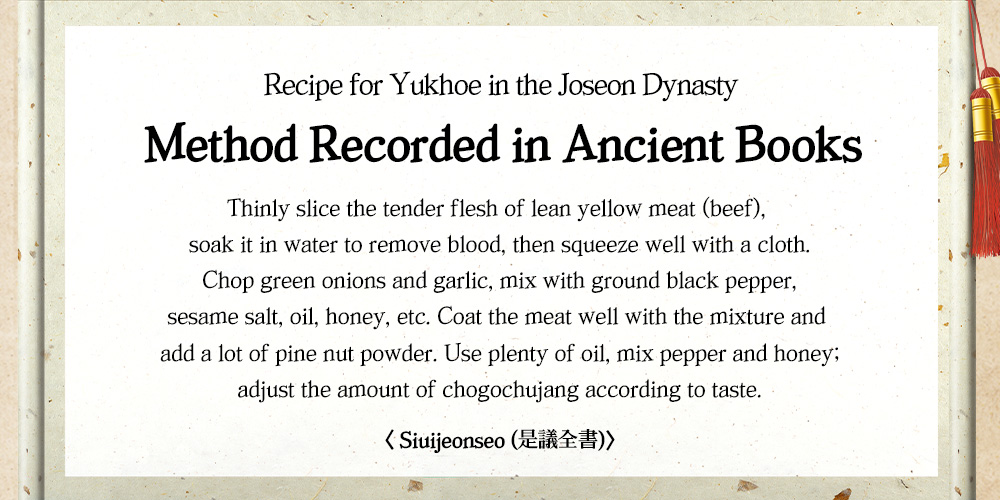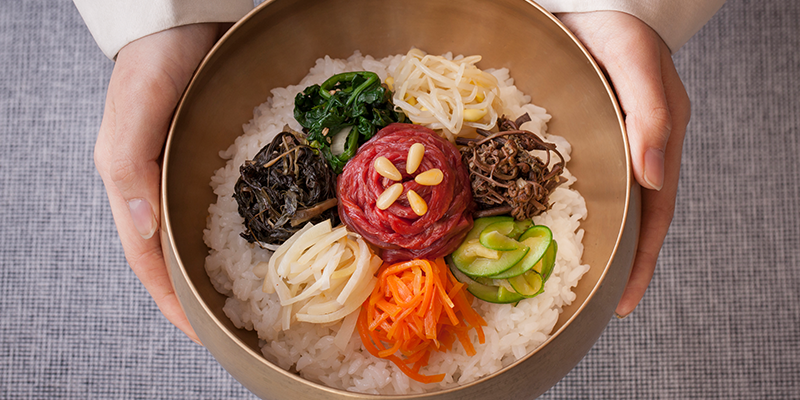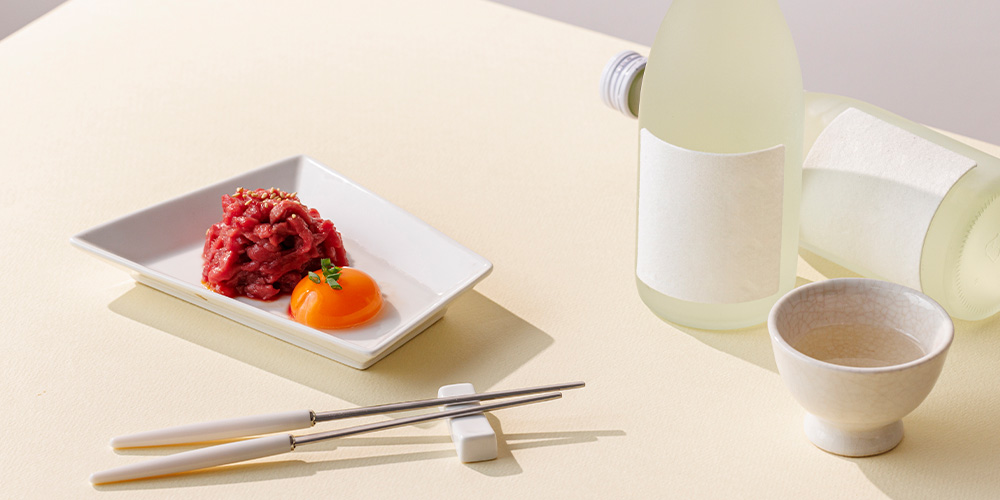한식 읽기 좋은 날
Yukhoe, A Vividly Authentic Taste
Editor's Letter

Meat brought within a few hours from the slaughterhouse is swiftly sliced. Even to the naked eye, its dense chewiness and fresh vigor can be felt.
When the blackish-red meat is introduced in the mouth, a savory taste lingers tantalizingly on the tip of the tongue. Yukhoe, a dish of raw meat that is uniquely traditional to Korea, takes you on an intuitive journey through the genuine flavor of meat.
Yukhoe has even become an indispensable menu for international pop stars and Hollywood celebrities in their course of Korean gastronomic tour to Gwangjang Market.

Raw Meat Culture Enjoyed regardless of Social Strata
Yukhoe is a culinary culture that particularly developed in Korea among the three East Asian countries. It is speculated that consumption of raw meat started from the influence of the Chinese Three Kingdoms period, or the hunting habits of nomads. According to records, despite the Buddhist culture in the Goryeo Dynasty that did not indulge in meat-eating, the consumption of meat continued in various ways for health recovery or to fulfill filial duties to parents. The same is true in the royal court. By the end of the Goryeo period, there were records of raising a considerable number of cattle, slaughtering them, and exporting the meat. It is said that various classes of people, including the nobility, consumed raw meat not only from cattle and horses, but also from pigs, chickens, quails, and other hunted animals.

In various compiled works from the Joseon Dynasty by unknown authors, such as 'Siuijeonseo (是議全書),' a culinary book, or 'Jinchan-ui Gwi (進饌儀軌),' which contains records of royal feasts from the later period of the Joseon Dynasty, detailed instructions on making yukhoe and gabhoe (raw beef entrails dish) are documented. It is evident from these writings that raw beef and entrails were served even for major rituals and palace banquets. Thus, consuming raw meat was considered a nourishing food enjoyed by people of all social classes, seeking health and well-being.
Brilliant crimson hue and chewy flavor that envelops the tongue
Yukhoe, eaten raw while the meat is extremely fresh, retains its nutrients and enzymes, allowing one to fully experience the original taste of the ingredient. When meat proteins are cooked over heat, they coagulate and become tougher. However, yukhoeuses lean cuts without fat that make it more tender than cooked meat, imparting a clean, savory taste that intensifies with each bite.

To preserve the fresh taste of raw meat, yukhoe is prepared with light seasoning, making it a suitable side dish for both drinking and dining occasions. Due to the emphasis on freshness, it was primarily consumed during the winter season and served to celebrate Seollal, the Korean New Year.
Diverse regional cultures of yukhoe

Seoul and Jinju in Gyeongsangnam-do were among the first areas in the early 20th century to establish slaughterhouses nationwide, which led to the proliferation of meat restaurants nearby, allowing people to enjoy high-quality, fresh yukhoe. The history of Jinju's specialty, yukhoe bibimbap, also began during this time. Yukhoe continues to be a local delicacy enjoyed in various types and styles in different regions, carrying on its tradition till this day.
# Beef Yukhoe and Gabhoe
Beef yukhoe uses tenderloin or other lean cuts with a fine texture and less fat compared to other parts of beef. The most popular form involves thinly slicing beef, marinating it in soy sauce, sprinkling with pine nuts, and serving with pear and garlic. In Jeolla Province, meat is seasoned with salt and served with ingredients like cheongpomuk (mung bean jelly salad) and water parsley or mixed with gochujang (red chili paste) based on personal preference.
Some enjoy raw beef without any seasoning, thinly sliced like sashimi, a style referred to as 'sengogi' or ‘yuk-sashimi’ in Jeollado or 'mungtigi' in Daegu. The term 'mungtigi' means ‘cut into thin pieces.’ Spread out like a flower around the plate, the meat proves its freshness by sticking firmly to the flat plate and refusing to fall off even when turned over. Gabhoe, which consists of internal organs like liver, tripe, and lung along with meat, is dipped in salt seasoning and eaten raw. This is primarily enjoyed in the Seoul and Gyeonggido area.
# Horse Yukhoe
With scenes of horses leisurely grazing in the meadow, Jeju Island, known for its horse breeding since the Goryeo Dynasty, developed a tradition of consuming horse meat. While horses were primarily used for military or transportation purposes rather than as food, Jeju Island's culinary culture continued, and horse meat has now become one of the local delicacies exclusive to the island.
Horse yukhoe is prepared mainly in two ways, similar to beef: marinated in a sauce or thinly sliced like sashimi. Due to the importance of freshness and the rearing environment, Jeju has separate 'Jeju Horse Meat Certified Sales Centers' that sell horse meat raised specifically for consumption.
# Chicken Yukhoe
Despite being commonly grilled, fried, steamed, and stir-fried, chicken can also be enjoyed in the form of yukhoe. Chicken yukhoe, available in regions like Gwangju, Suncheon, and Mokpo in South Jeolla Province, might be unfamiliar in areas outside Jeollado, but its history dates back as far as horse meat. Maintaining freshness is crucial for chicken yukhoe, so it is prepared immediately upon order, ensuring quality by using freshly slaughteredchickens.
Usually, chicken breast is used for yukhoe, but occasionally, special parts such as chicken gizzards, liver, or feet are also used, particularly relished by food enthusiasts for their crunchy texture. It is also notable that unlike other yukhoe, chicken yukhoe has variations in how it is prepared and served according to each household’s own preference; for example, finely chopping green onions to accompany raw chicken dipped in sesame oil or marinating raw chicken breast with seasoned gochujang and onions.
#Quail Yukhoe
Quail was actually more frequently consumed during the Goryeo Dynasty compared to chicken. Until the Joseon Dynasty, quail was served as a primary source of protein. However, due to the necessity of hunting them in the wild, over time, they were largely replaced by chickens, which could be raised domestically. Quail meat has low fat content and high protein, resulting in a firm texture. During winter, quail was caught, gutted, and their meat was frozen by placing them on ice or in the snow. The hardened meat was thinly sliced and eaten as Dongchihoe (frozen quail sashimi), seasoned with chojang (red chilli paste with vinegar), ginger, and green onions.
Currently, near Suanbo in Chueogju, quail cuisine is renowned. At restaurants specializing in quail dishes run by experts in quail cuisine, one can savor various quail dishes like yukhoe, sushi, bulgogi, sujebi (hand-pulled dough soup), mandu (dumplings), jeon (pancakes), and more as part of a course meal. Quail yukhoe, which is served as the first menu of the course, is prepared with tender breast meat known for its delicate flavor, and it must be consumed within 10 minutes of being served.
Raw Meat Yukhoe, Representing the Diversity of Korean Cuisine
There are many constraints to enjoying raw meat. First, freshness is crucial, and one must carefully choose and balance condiments and seasonings considering the aroma, texture, and hygiene of the meat. Despite these limitations, the culture of consuming raw meat, which has evolved into a unique culinary world while preserving its nutrition, enzymes, and taste, is a remarkable representation of the diversity and excellence of Korean cuisine.

The aesthetics of enjoying raw meat might seem restrained, but it presents a variety of flavors. So, make sure to experience the delectable nuances of yukhoe accompanied by a glass of soju that will surely add warmth and pleasure to your chilly winter season.
References: Encyclopedia of Korean Culture, Encyclopeia of Korean Culture of Basic Necessities (National Folk Museum of Korea, 2018), A Culinary Study of the Historical Development of Korean Yukhoe (Park Gyeong-ran, Korean Association of Human Ecology, 2019)

 한국어
한국어
 English
English






